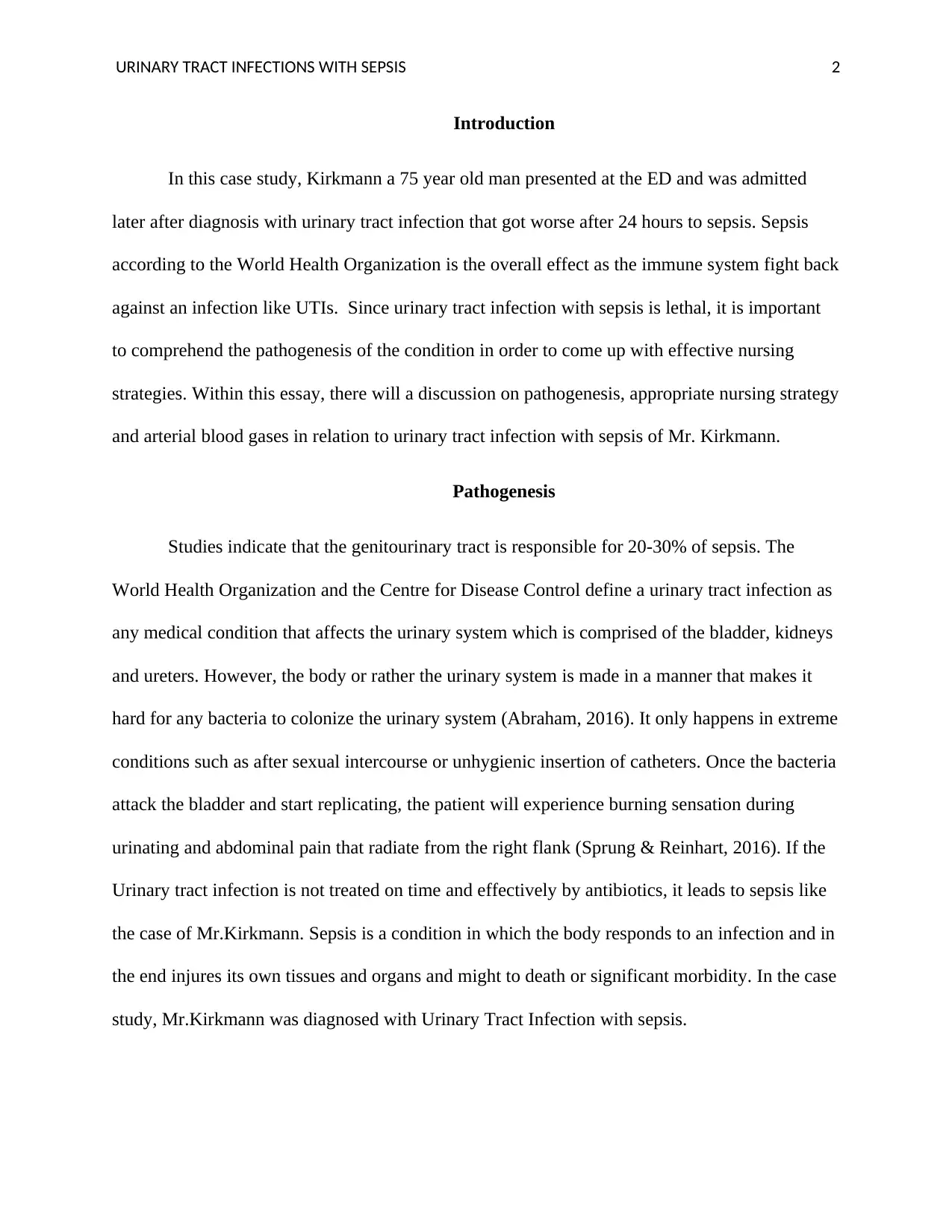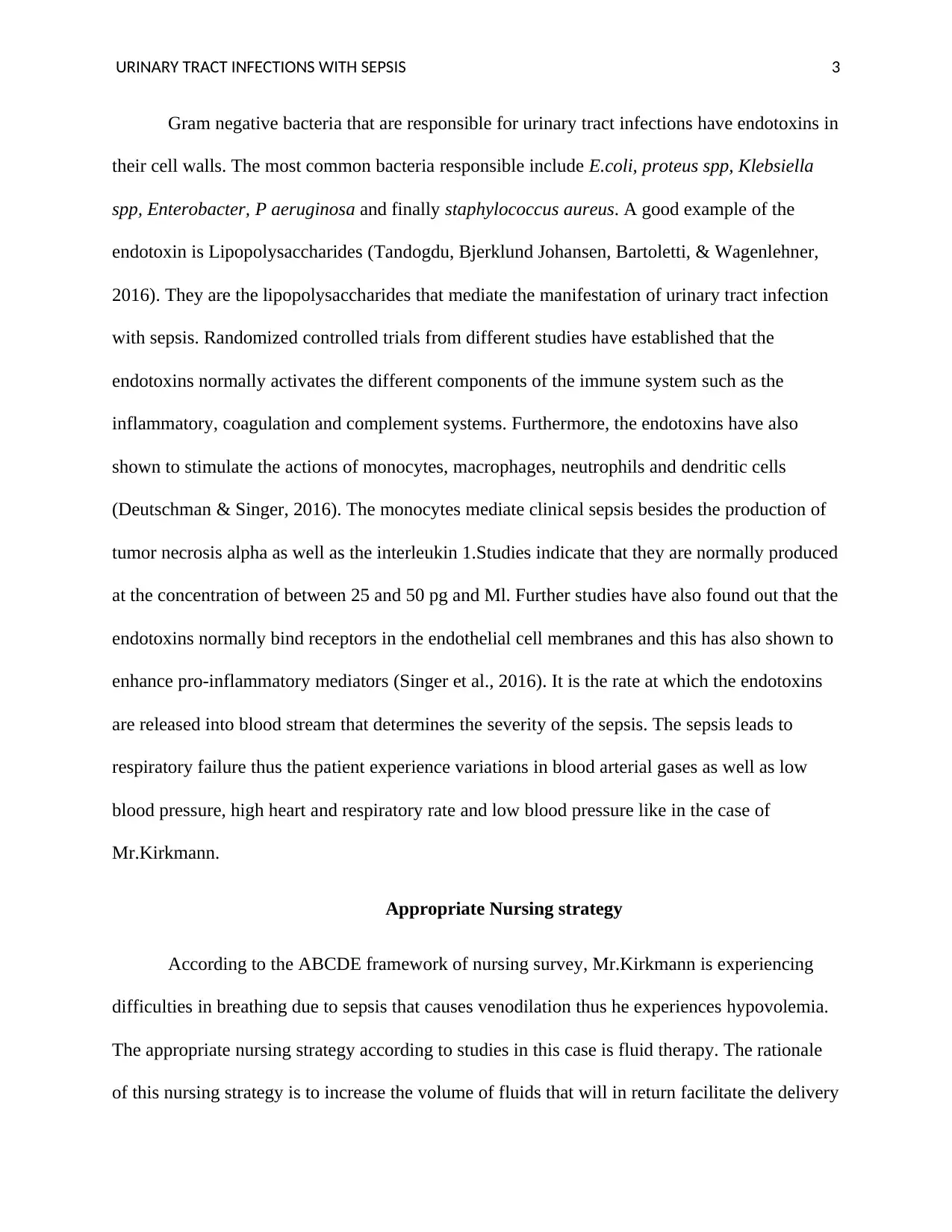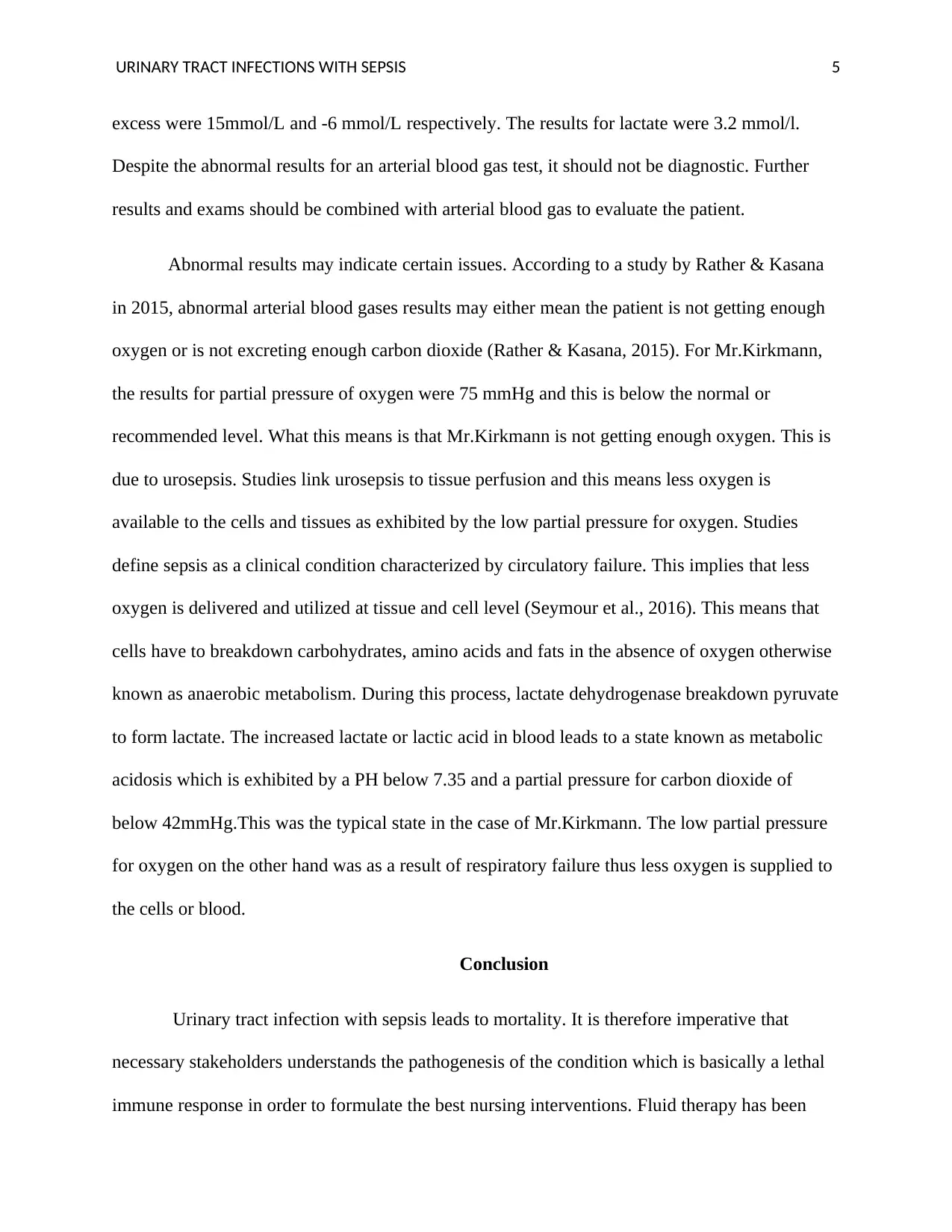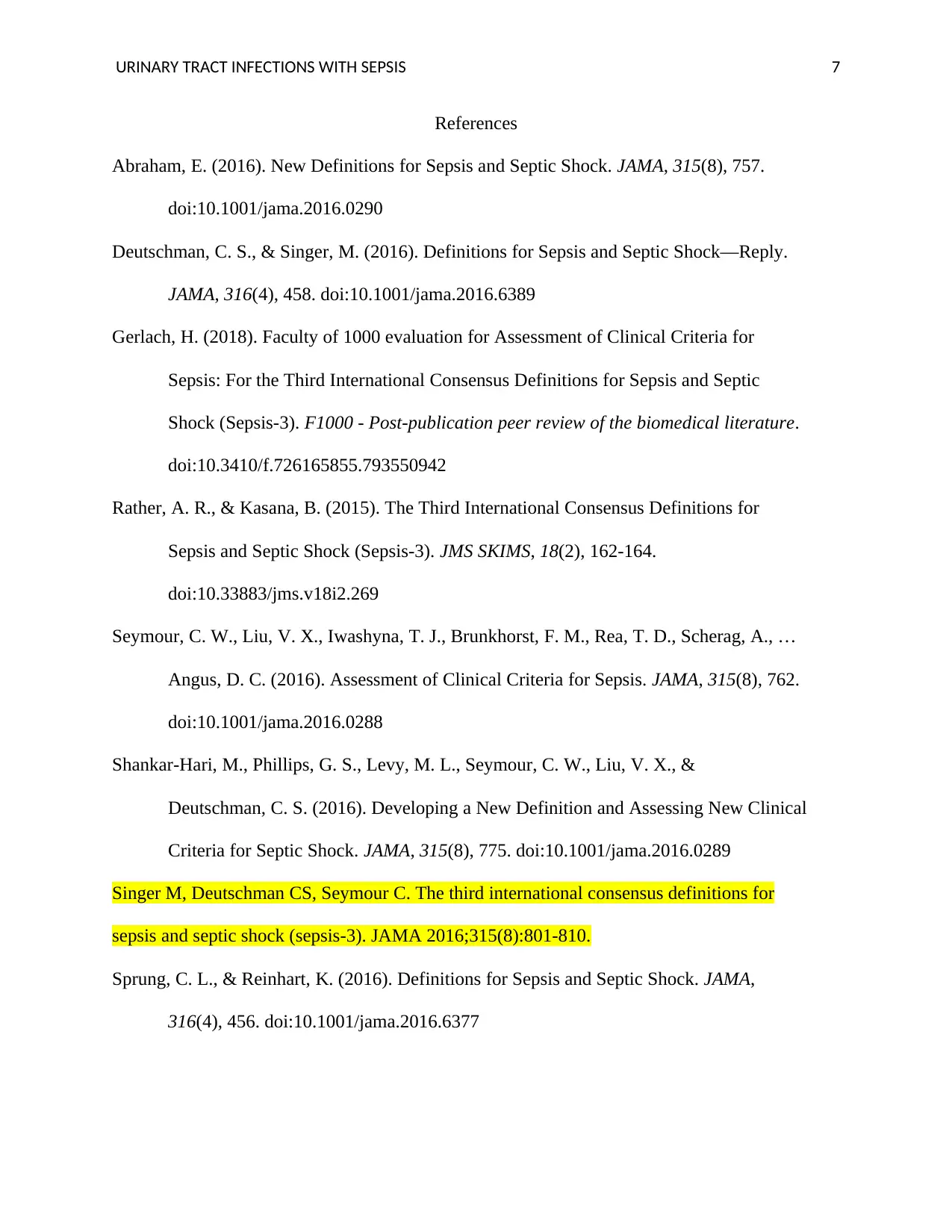Analysis of Urinary Tract Infection with Sepsis: A Case Study
VerifiedAdded on 2022/12/22
|8
|1765
|44
Case Study
AI Summary
This case study analyzes the case of Mr. Kirkman, a 75-year-old male admitted with a urinary tract infection that progressed to sepsis. The assignment explores the pathogenesis of the condition, including the role of gram-negative bacteria and endotoxins in triggering an immune response leading to sepsis. It examines the clinical manifestations, such as burning sensation during urination and abdominal pain, and the progression to systemic effects. The study identifies fluid therapy as an appropriate nursing strategy based on the ABCDE framework, explaining its rationale in addressing hypovolemia and improving tissue perfusion. Furthermore, the case study critically analyzes arterial blood gas (ABG) results, relating them to the underlying pathogenesis and the patient's respiratory and metabolic state. The analysis highlights the significance of abnormal ABG results, such as low partial pressure of oxygen and metabolic acidosis, in diagnosing and managing sepsis. The study emphasizes the importance of understanding the condition's pathogenesis to formulate effective nursing interventions and improve patient outcomes, including the need for further research on effective nursing strategies.

Running head: URINARY TRACT INFECTION WITH SEPSIS 1
Urinary tract infection with sepsis
Name:
Institution:
Tutor:
Date:
Urinary tract infection with sepsis
Name:
Institution:
Tutor:
Date:
Paraphrase This Document
Need a fresh take? Get an instant paraphrase of this document with our AI Paraphraser

URINARY TRACT INFECTIONS WITH SEPSIS 2
Introduction
In this case study, Kirkmann a 75 year old man presented at the ED and was admitted
later after diagnosis with urinary tract infection that got worse after 24 hours to sepsis. Sepsis
according to the World Health Organization is the overall effect as the immune system fight back
against an infection like UTIs. Since urinary tract infection with sepsis is lethal, it is important
to comprehend the pathogenesis of the condition in order to come up with effective nursing
strategies. Within this essay, there will a discussion on pathogenesis, appropriate nursing strategy
and arterial blood gases in relation to urinary tract infection with sepsis of Mr. Kirkmann.
Pathogenesis
Studies indicate that the genitourinary tract is responsible for 20-30% of sepsis. The
World Health Organization and the Centre for Disease Control define a urinary tract infection as
any medical condition that affects the urinary system which is comprised of the bladder, kidneys
and ureters. However, the body or rather the urinary system is made in a manner that makes it
hard for any bacteria to colonize the urinary system (Abraham, 2016). It only happens in extreme
conditions such as after sexual intercourse or unhygienic insertion of catheters. Once the bacteria
attack the bladder and start replicating, the patient will experience burning sensation during
urinating and abdominal pain that radiate from the right flank (Sprung & Reinhart, 2016). If the
Urinary tract infection is not treated on time and effectively by antibiotics, it leads to sepsis like
the case of Mr.Kirkmann. Sepsis is a condition in which the body responds to an infection and in
the end injures its own tissues and organs and might to death or significant morbidity. In the case
study, Mr.Kirkmann was diagnosed with Urinary Tract Infection with sepsis.
Introduction
In this case study, Kirkmann a 75 year old man presented at the ED and was admitted
later after diagnosis with urinary tract infection that got worse after 24 hours to sepsis. Sepsis
according to the World Health Organization is the overall effect as the immune system fight back
against an infection like UTIs. Since urinary tract infection with sepsis is lethal, it is important
to comprehend the pathogenesis of the condition in order to come up with effective nursing
strategies. Within this essay, there will a discussion on pathogenesis, appropriate nursing strategy
and arterial blood gases in relation to urinary tract infection with sepsis of Mr. Kirkmann.
Pathogenesis
Studies indicate that the genitourinary tract is responsible for 20-30% of sepsis. The
World Health Organization and the Centre for Disease Control define a urinary tract infection as
any medical condition that affects the urinary system which is comprised of the bladder, kidneys
and ureters. However, the body or rather the urinary system is made in a manner that makes it
hard for any bacteria to colonize the urinary system (Abraham, 2016). It only happens in extreme
conditions such as after sexual intercourse or unhygienic insertion of catheters. Once the bacteria
attack the bladder and start replicating, the patient will experience burning sensation during
urinating and abdominal pain that radiate from the right flank (Sprung & Reinhart, 2016). If the
Urinary tract infection is not treated on time and effectively by antibiotics, it leads to sepsis like
the case of Mr.Kirkmann. Sepsis is a condition in which the body responds to an infection and in
the end injures its own tissues and organs and might to death or significant morbidity. In the case
study, Mr.Kirkmann was diagnosed with Urinary Tract Infection with sepsis.

URINARY TRACT INFECTIONS WITH SEPSIS 3
Gram negative bacteria that are responsible for urinary tract infections have endotoxins in
their cell walls. The most common bacteria responsible include E.coli, proteus spp, Klebsiella
spp, Enterobacter, P aeruginosa and finally staphylococcus aureus. A good example of the
endotoxin is Lipopolysaccharides (Tandogdu, Bjerklund Johansen, Bartoletti, & Wagenlehner,
2016). They are the lipopolysaccharides that mediate the manifestation of urinary tract infection
with sepsis. Randomized controlled trials from different studies have established that the
endotoxins normally activates the different components of the immune system such as the
inflammatory, coagulation and complement systems. Furthermore, the endotoxins have also
shown to stimulate the actions of monocytes, macrophages, neutrophils and dendritic cells
(Deutschman & Singer, 2016). The monocytes mediate clinical sepsis besides the production of
tumor necrosis alpha as well as the interleukin 1.Studies indicate that they are normally produced
at the concentration of between 25 and 50 pg and Ml. Further studies have also found out that the
endotoxins normally bind receptors in the endothelial cell membranes and this has also shown to
enhance pro-inflammatory mediators (Singer et al., 2016). It is the rate at which the endotoxins
are released into blood stream that determines the severity of the sepsis. The sepsis leads to
respiratory failure thus the patient experience variations in blood arterial gases as well as low
blood pressure, high heart and respiratory rate and low blood pressure like in the case of
Mr.Kirkmann.
Appropriate Nursing strategy
According to the ABCDE framework of nursing survey, Mr.Kirkmann is experiencing
difficulties in breathing due to sepsis that causes venodilation thus he experiences hypovolemia.
The appropriate nursing strategy according to studies in this case is fluid therapy. The rationale
of this nursing strategy is to increase the volume of fluids that will in return facilitate the delivery
Gram negative bacteria that are responsible for urinary tract infections have endotoxins in
their cell walls. The most common bacteria responsible include E.coli, proteus spp, Klebsiella
spp, Enterobacter, P aeruginosa and finally staphylococcus aureus. A good example of the
endotoxin is Lipopolysaccharides (Tandogdu, Bjerklund Johansen, Bartoletti, & Wagenlehner,
2016). They are the lipopolysaccharides that mediate the manifestation of urinary tract infection
with sepsis. Randomized controlled trials from different studies have established that the
endotoxins normally activates the different components of the immune system such as the
inflammatory, coagulation and complement systems. Furthermore, the endotoxins have also
shown to stimulate the actions of monocytes, macrophages, neutrophils and dendritic cells
(Deutschman & Singer, 2016). The monocytes mediate clinical sepsis besides the production of
tumor necrosis alpha as well as the interleukin 1.Studies indicate that they are normally produced
at the concentration of between 25 and 50 pg and Ml. Further studies have also found out that the
endotoxins normally bind receptors in the endothelial cell membranes and this has also shown to
enhance pro-inflammatory mediators (Singer et al., 2016). It is the rate at which the endotoxins
are released into blood stream that determines the severity of the sepsis. The sepsis leads to
respiratory failure thus the patient experience variations in blood arterial gases as well as low
blood pressure, high heart and respiratory rate and low blood pressure like in the case of
Mr.Kirkmann.
Appropriate Nursing strategy
According to the ABCDE framework of nursing survey, Mr.Kirkmann is experiencing
difficulties in breathing due to sepsis that causes venodilation thus he experiences hypovolemia.
The appropriate nursing strategy according to studies in this case is fluid therapy. The rationale
of this nursing strategy is to increase the volume of fluids that will in return facilitate the delivery
⊘ This is a preview!⊘
Do you want full access?
Subscribe today to unlock all pages.

Trusted by 1+ million students worldwide

URINARY TRACT INFECTIONS WITH SEPSIS 4
of oxygen to tissues and prevent tissue perfusion. Several studies have established that using
crystalloids like isotonic sodium chloride or the lactated Ringers solution can assist patients with
urosepsis (Gerlach, 2018). This therapy has also in recent studies show that it can be used to
resuscitate the patient. However, it is recommended that fluid therapy should be combined with
other nursing strategies there is increased permeability in veins and therefore fluids alone would
leak continuously.
Analysis of arterial blood gases
An arterial blood gas test also known as blood gas analysis, is a test conducted on
patients to estimate the levels of oxygen and carbon dioxide in the blood. Furthermore, the test
also reveals blood PH, Bicarbonates, Base excess, lactate and how the lung function. Normally,
it is conducted during emergency situations to assist in diagnosing the underlying cause of
difficulty in breathing.
The normal values for the arterial blood gases vary from one laboratory to another. The
variation according to results is as a result of the difference in altitude or sea level. However, the
recommended normal values should be as follows: For partial pressure for oxygen and carbon
dioxide, the values should be between 75 to 100 mmHg and 35 to 45 mmHg respectively
(Shankar-Hari et al., 2016). That of oxygen saturation should be between 94 and 100% while the
normal levels of bicarbonates and base excess should be 22 to 26 mEq/L and -6mmol/L
respectively. Finally, the normal PH for blood should be between 7.35 and 7.45.
All the results in the case of Mr.Kirkmann for the arterial blood gases were not within the
normal range. The results for PH was 7.25 while those of the partial pressure for oxygen and
carbon dioxide were 75mmHg and 32 mmHg respectively. The results for Bicarbonates and base
of oxygen to tissues and prevent tissue perfusion. Several studies have established that using
crystalloids like isotonic sodium chloride or the lactated Ringers solution can assist patients with
urosepsis (Gerlach, 2018). This therapy has also in recent studies show that it can be used to
resuscitate the patient. However, it is recommended that fluid therapy should be combined with
other nursing strategies there is increased permeability in veins and therefore fluids alone would
leak continuously.
Analysis of arterial blood gases
An arterial blood gas test also known as blood gas analysis, is a test conducted on
patients to estimate the levels of oxygen and carbon dioxide in the blood. Furthermore, the test
also reveals blood PH, Bicarbonates, Base excess, lactate and how the lung function. Normally,
it is conducted during emergency situations to assist in diagnosing the underlying cause of
difficulty in breathing.
The normal values for the arterial blood gases vary from one laboratory to another. The
variation according to results is as a result of the difference in altitude or sea level. However, the
recommended normal values should be as follows: For partial pressure for oxygen and carbon
dioxide, the values should be between 75 to 100 mmHg and 35 to 45 mmHg respectively
(Shankar-Hari et al., 2016). That of oxygen saturation should be between 94 and 100% while the
normal levels of bicarbonates and base excess should be 22 to 26 mEq/L and -6mmol/L
respectively. Finally, the normal PH for blood should be between 7.35 and 7.45.
All the results in the case of Mr.Kirkmann for the arterial blood gases were not within the
normal range. The results for PH was 7.25 while those of the partial pressure for oxygen and
carbon dioxide were 75mmHg and 32 mmHg respectively. The results for Bicarbonates and base
Paraphrase This Document
Need a fresh take? Get an instant paraphrase of this document with our AI Paraphraser

URINARY TRACT INFECTIONS WITH SEPSIS 5
excess were 15mmol/L and -6 mmol/L respectively. The results for lactate were 3.2 mmol/l.
Despite the abnormal results for an arterial blood gas test, it should not be diagnostic. Further
results and exams should be combined with arterial blood gas to evaluate the patient.
Abnormal results may indicate certain issues. According to a study by Rather & Kasana
in 2015, abnormal arterial blood gases results may either mean the patient is not getting enough
oxygen or is not excreting enough carbon dioxide (Rather & Kasana, 2015). For Mr.Kirkmann,
the results for partial pressure of oxygen were 75 mmHg and this is below the normal or
recommended level. What this means is that Mr.Kirkmann is not getting enough oxygen. This is
due to urosepsis. Studies link urosepsis to tissue perfusion and this means less oxygen is
available to the cells and tissues as exhibited by the low partial pressure for oxygen. Studies
define sepsis as a clinical condition characterized by circulatory failure. This implies that less
oxygen is delivered and utilized at tissue and cell level (Seymour et al., 2016). This means that
cells have to breakdown carbohydrates, amino acids and fats in the absence of oxygen otherwise
known as anaerobic metabolism. During this process, lactate dehydrogenase breakdown pyruvate
to form lactate. The increased lactate or lactic acid in blood leads to a state known as metabolic
acidosis which is exhibited by a PH below 7.35 and a partial pressure for carbon dioxide of
below 42mmHg.This was the typical state in the case of Mr.Kirkmann. The low partial pressure
for oxygen on the other hand was as a result of respiratory failure thus less oxygen is supplied to
the cells or blood.
Conclusion
Urinary tract infection with sepsis leads to mortality. It is therefore imperative that
necessary stakeholders understands the pathogenesis of the condition which is basically a lethal
immune response in order to formulate the best nursing interventions. Fluid therapy has been
excess were 15mmol/L and -6 mmol/L respectively. The results for lactate were 3.2 mmol/l.
Despite the abnormal results for an arterial blood gas test, it should not be diagnostic. Further
results and exams should be combined with arterial blood gas to evaluate the patient.
Abnormal results may indicate certain issues. According to a study by Rather & Kasana
in 2015, abnormal arterial blood gases results may either mean the patient is not getting enough
oxygen or is not excreting enough carbon dioxide (Rather & Kasana, 2015). For Mr.Kirkmann,
the results for partial pressure of oxygen were 75 mmHg and this is below the normal or
recommended level. What this means is that Mr.Kirkmann is not getting enough oxygen. This is
due to urosepsis. Studies link urosepsis to tissue perfusion and this means less oxygen is
available to the cells and tissues as exhibited by the low partial pressure for oxygen. Studies
define sepsis as a clinical condition characterized by circulatory failure. This implies that less
oxygen is delivered and utilized at tissue and cell level (Seymour et al., 2016). This means that
cells have to breakdown carbohydrates, amino acids and fats in the absence of oxygen otherwise
known as anaerobic metabolism. During this process, lactate dehydrogenase breakdown pyruvate
to form lactate. The increased lactate or lactic acid in blood leads to a state known as metabolic
acidosis which is exhibited by a PH below 7.35 and a partial pressure for carbon dioxide of
below 42mmHg.This was the typical state in the case of Mr.Kirkmann. The low partial pressure
for oxygen on the other hand was as a result of respiratory failure thus less oxygen is supplied to
the cells or blood.
Conclusion
Urinary tract infection with sepsis leads to mortality. It is therefore imperative that
necessary stakeholders understands the pathogenesis of the condition which is basically a lethal
immune response in order to formulate the best nursing interventions. Fluid therapy has been

URINARY TRACT INFECTIONS WITH SEPSIS 6
used in the past but it does not combat tissue perfusion. Research should therefore be conducted
to come up with the best nursing strategy.
used in the past but it does not combat tissue perfusion. Research should therefore be conducted
to come up with the best nursing strategy.
⊘ This is a preview!⊘
Do you want full access?
Subscribe today to unlock all pages.

Trusted by 1+ million students worldwide

URINARY TRACT INFECTIONS WITH SEPSIS 7
References
Abraham, E. (2016). New Definitions for Sepsis and Septic Shock. JAMA, 315(8), 757.
doi:10.1001/jama.2016.0290
Deutschman, C. S., & Singer, M. (2016). Definitions for Sepsis and Septic Shock—Reply.
JAMA, 316(4), 458. doi:10.1001/jama.2016.6389
Gerlach, H. (2018). Faculty of 1000 evaluation for Assessment of Clinical Criteria for
Sepsis: For the Third International Consensus Definitions for Sepsis and Septic
Shock (Sepsis-3). F1000 - Post-publication peer review of the biomedical literature.
doi:10.3410/f.726165855.793550942
Rather, A. R., & Kasana, B. (2015). The Third International Consensus Definitions for
Sepsis and Septic Shock (Sepsis-3). JMS SKIMS, 18(2), 162-164.
doi:10.33883/jms.v18i2.269
Seymour, C. W., Liu, V. X., Iwashyna, T. J., Brunkhorst, F. M., Rea, T. D., Scherag, A., …
Angus, D. C. (2016). Assessment of Clinical Criteria for Sepsis. JAMA, 315(8), 762.
doi:10.1001/jama.2016.0288
Shankar-Hari, M., Phillips, G. S., Levy, M. L., Seymour, C. W., Liu, V. X., &
Deutschman, C. S. (2016). Developing a New Definition and Assessing New Clinical
Criteria for Septic Shock. JAMA, 315(8), 775. doi:10.1001/jama.2016.0289
Singer M, Deutschman CS, Seymour C. The third international consensus definitions for
sepsis and septic shock (sepsis-3). JAMA 2016;315(8):801-810.
Sprung, C. L., & Reinhart, K. (2016). Definitions for Sepsis and Septic Shock. JAMA,
316(4), 456. doi:10.1001/jama.2016.6377
References
Abraham, E. (2016). New Definitions for Sepsis and Septic Shock. JAMA, 315(8), 757.
doi:10.1001/jama.2016.0290
Deutschman, C. S., & Singer, M. (2016). Definitions for Sepsis and Septic Shock—Reply.
JAMA, 316(4), 458. doi:10.1001/jama.2016.6389
Gerlach, H. (2018). Faculty of 1000 evaluation for Assessment of Clinical Criteria for
Sepsis: For the Third International Consensus Definitions for Sepsis and Septic
Shock (Sepsis-3). F1000 - Post-publication peer review of the biomedical literature.
doi:10.3410/f.726165855.793550942
Rather, A. R., & Kasana, B. (2015). The Third International Consensus Definitions for
Sepsis and Septic Shock (Sepsis-3). JMS SKIMS, 18(2), 162-164.
doi:10.33883/jms.v18i2.269
Seymour, C. W., Liu, V. X., Iwashyna, T. J., Brunkhorst, F. M., Rea, T. D., Scherag, A., …
Angus, D. C. (2016). Assessment of Clinical Criteria for Sepsis. JAMA, 315(8), 762.
doi:10.1001/jama.2016.0288
Shankar-Hari, M., Phillips, G. S., Levy, M. L., Seymour, C. W., Liu, V. X., &
Deutschman, C. S. (2016). Developing a New Definition and Assessing New Clinical
Criteria for Septic Shock. JAMA, 315(8), 775. doi:10.1001/jama.2016.0289
Singer M, Deutschman CS, Seymour C. The third international consensus definitions for
sepsis and septic shock (sepsis-3). JAMA 2016;315(8):801-810.
Sprung, C. L., & Reinhart, K. (2016). Definitions for Sepsis and Septic Shock. JAMA,
316(4), 456. doi:10.1001/jama.2016.6377
Paraphrase This Document
Need a fresh take? Get an instant paraphrase of this document with our AI Paraphraser

URINARY TRACT INFECTIONS WITH SEPSIS 8
Tandogdu, Z., Bjerklund Johansen, T. E., Bartoletti, R., & Wagenlehner, F. (2016).
Management of the Urologic Sepsis Syndrome. European Urology Supplements,
15(4), 102-111. doi:10.1016/j.eursup.2016.04.004
Tandogdu, Z., Bjerklund Johansen, T. E., Bartoletti, R., & Wagenlehner, F. (2016).
Management of the Urologic Sepsis Syndrome. European Urology Supplements,
15(4), 102-111. doi:10.1016/j.eursup.2016.04.004
1 out of 8
Related Documents
Your All-in-One AI-Powered Toolkit for Academic Success.
+13062052269
info@desklib.com
Available 24*7 on WhatsApp / Email
![[object Object]](/_next/static/media/star-bottom.7253800d.svg)
Unlock your academic potential
Copyright © 2020–2025 A2Z Services. All Rights Reserved. Developed and managed by ZUCOL.





